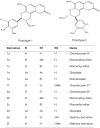Development of QSAR model for immunomodulatory activity of natural coumarinolignoids
- PMID: 20856844
- PMCID: PMC2939762
- DOI: 10.2147/dddt.s10875
Development of QSAR model for immunomodulatory activity of natural coumarinolignoids
Abstract
Immunomodulation is the process of alteration in immune response due to foreign intrusion of molecules inside the body. Along with the available drugs, a large number of herbal drugs are promoted in traditional Indian treatments, for their immunomodulating activity. Natural coumarinolignoids isolated from the seeds of Cleome viscose have been recognized as having hepatoprotective action and have recently been tested preclinically for their immunomodulatory activity affecting both cell-mediated and humoral immune response. To explore the immunomodulatory compound from derivatives of coumarinolignoids, a quantitative structure activity relationship (QSAR) and molecular docking studies were performed. Theoretical results are in accord with the in vivo experimental data studied on Swiss albino mice. Immunostimulatory activity was predicted through QSAR model, developed by forward feed multiple linear regression method with leave-one-out approach. Relationship correlating measure of QSAR model was 99% (R(2) = 0.99) and predictive accuracy was 96% (RCV(2) = 0.96). QSAR studies indicate that dipole moment, steric energy, amide group count, lambda max (UV-visible), and molar refractivity correlates well with biological activity, while decrease in dipole moment, steric energy, and molar refractivity has negative correlation. Docking studies also showed strong binding affinity to immunomodulatory receptors.
Keywords: QSAR; coumarinolignoids; docking; immunomodulation; regression model.
Figures






Similar articles
-
In silico exploration of anti-inflammatory activity of natural coumarinolignoids.Chem Biol Drug Des. 2011 Oct;78(4):567-79. doi: 10.1111/j.1747-0285.2011.01173.x. Epub 2011 Aug 29. Chem Biol Drug Des. 2011. PMID: 21736704
-
Pharmacophore modeling, molecular docking, QSAR, and in silico ADMET studies of gallic acid derivatives for immunomodulatory activity.J Mol Model. 2012 Jun;18(6):2513-25. doi: 10.1007/s00894-011-1265-3. Epub 2011 Oct 27. J Mol Model. 2012. PMID: 22038459
-
QSAR, docking and in vivo studies for immunomodulatory activity of isolated triterpenoids from Eucalyptus tereticornis and Gentiana kurroo.Eur J Pharm Sci. 2012 Aug 30;47(1):152-61. doi: 10.1016/j.ejps.2012.05.009. Epub 2012 May 30. Eur J Pharm Sci. 2012. PMID: 22659375
-
Role of Topological, Electronic, Geometrical, Constitutional and Quantum Chemical Based Descriptors in QSAR: mPGES-1 as a Case Study.Curr Top Med Chem. 2018;18(13):1075-1090. doi: 10.2174/1568026618666180719164149. Curr Top Med Chem. 2018. PMID: 30027847 Review.
-
Natural and Synthetic Coumarins with Effects on Inflammation.Molecules. 2016 Oct 2;21(10):1322. doi: 10.3390/molecules21101322. Molecules. 2016. PMID: 27706093 Free PMC article. Review.
Cited by
-
Computer-Aided Drug Design in Epigenetics.Front Chem. 2018 Mar 12;6:57. doi: 10.3389/fchem.2018.00057. eCollection 2018. Front Chem. 2018. PMID: 29594101 Free PMC article. Review.
-
Combining structure-based pharmacophore modeling, virtual screening, and in silico ADMET analysis to discover novel tetrahydro-quinoline based pyruvate kinase isozyme M2 activators with antitumor activity.Drug Des Devel Ther. 2014 Sep 2;8:1195-210. doi: 10.2147/DDDT.S62921. eCollection 2014. Drug Des Devel Ther. 2014. PMID: 25214764 Free PMC article.
-
Systematic computational strategies for identifying protein targets and lead discovery.RSC Med Chem. 2024 May 31;15(7):2254-2269. doi: 10.1039/d4md00223g. eCollection 2024 Jul 17. RSC Med Chem. 2024. PMID: 39026640 Free PMC article. Review.
-
Bioassay Directed Isolation, Biological Evaluation and in Silico Studies of New Isolates from Pteris cretica L.Antioxidants (Basel). 2019 Jul 19;8(7):231. doi: 10.3390/antiox8070231. Antioxidants (Basel). 2019. PMID: 31331076 Free PMC article.
-
Computational Modeling on Aquaporin-3 as Skin Cancer Target: A Virtual Screening Study.Front Chem. 2020 Apr 15;8:250. doi: 10.3389/fchem.2020.00250. eCollection 2020. Front Chem. 2020. PMID: 32351935 Free PMC article.
References
-
- Wagner H. Search for plant derived natural products with immunostimulatory activity (recent advances) Pure and Appl Chem. 1990;62(7):1217–1222.
-
- Ray AB, Chattopadhyay SK, Konno SKC, Kiso Y, Hikino H. Structures of cleomiscosins, coumarinolignoids of Cleome viscosa seeds. Tetrahedron. 1985;41:209–214.
-
- Bawankule DU, Chattopadhyay SK, Pal A, et al. Modulation of inflammatory mediators by coumarinolignoids from Cleome viscosa in female Swiss albino mice. Inflammopharm. 2008;16:1–6. - PubMed
-
- Chattopadhyay SK, Uniyal GD, Chattopadhyay SK, et al. Analysis of taxol and major taxoids in Himalayan yew. Taxus wallichiana J Chromatography . 1999;858:239–244. - PubMed
Publication types
MeSH terms
Substances
LinkOut - more resources
Full Text Sources

